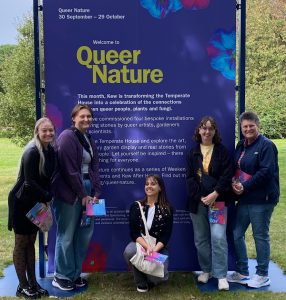How often do we hear from the pulpit and from lawmakers that diverse sexualities and genders are unnatural? This year, the United States already has set records for anti-LGBTQ legislative bills, and violence against queer people, especially trans and nonbinary people, continues to rise.
Given that, as they argue, gender and sexuality are natural, I have to wonder why some people must work so hard to enforce binary gender and heterosexuality.
Perhaps it’s because queerness isn’t at all unnatural. In fact, it’s positively a part of nature.
Queer plants

Susan Shaw (far right) with students in London.
I’m leading a study abroad in London right now, and last week I took my students to the Royal Botanic Gardens at Kew for a special exhibit on “Queer Nature.” We learned that, if we look at the plant world, we can see queerness everywhere.
For example, many modern palms are bisexual; their flowers have both “male” and “female” reproductive organs. Some palms have separate male and female flowers on the same plant; and some palms have separate male and female plants.
Citrus plants can reproduce asexually. The female plant doesn’t need fertilization but produces seeds that yield clones.
“By projecting human binaries on plants, we overlook their real complexities.”
Even the terms “male” and “female” are problematic when we apply them to plants. Botanist Carl Linnaeus used the terms in his classification of plants to help people understand plant biology. Unfortunately, this lens drawn from heteronormative human sexuality actually obscures plant diversity. By projecting human binaries on plants, we overlook their real complexities.
For example, some plants can change sex over time. Yew trees are distinctly male and female, but in Scotland in 2015, a 5,000-year old male Yew began to sprout berries. For some trees like ash and striped maple changing sex is fairly common. Scientists suggest this is likely because of environmental factors that stress trees or threaten reproduction.
Queer animals
It’s not only the plant world that’s queer. So is the animal world.
Scientists have observed same-sex sexual activity in at least 1,500 animal species from bearded dragons to barn owls to baboons and bonobos.
 One-third of Laysan Albatross pairs on Oahu are female partners. The birds will engage in sex with males to produce offspring but will return to their mates to lay eggs and raise their chicks together.
One-third of Laysan Albatross pairs on Oahu are female partners. The birds will engage in sex with males to produce offspring but will return to their mates to lay eggs and raise their chicks together.
A new study published last week suggests same-sex relationships also help animals build social relationships and community and mitigate conflict. These same-sex behaviors are more likely to be found in social animals that need community to survive.
Some scientists hypothesize that indiscriminate sexual mating actually predated the preference for heterosexual mating. Contemporary same-sex mating, then, is simply a holdover from animals’ evolutionary past, and they engage in it because they want to.
In other words, same-sex relationships are just part of the norm of animal behavior. These scientists suggest the question is not “Why do animals engage in same-sex behavior?” but “Why not?”
Queer humans
If queerness is so pervasive in the plant and animal world, why wouldn’t we expect to find it in the human world? Sure, human sexuality and gender are not exactly the same as plant and animal sex and sexual behavior, but if gender and sexual diversity are so commonplace — so natural — in the rest of the living world, wouldn’t the same be true of humans as part of the continuum of life on this planet?
“If queerness is so pervasive in the plant and animal world, why wouldn’t we expect to find it in the human world?”
Often politicians and pastors fall back on the argument that queerness is unnatural. There are naturally only two sexes, they argue, male and female, and these two sexes are naturally attracted to one another. But nature itself shows us what’s actually natural among living things is great diversity in gender and sexual behavior.
Moving along the continuums of gender and sexuality is, in reality, the most natural thing in the world.
Queering the Bible
When read through the lens of queerness, the Bible itself offers challenges and disruptions to binary and heteronormative constructions of reality.
“Queer” is what’s at odds with the norm. Reading the Bible through queer lenses means looking for those places where we find ambiguities in the text, people or situations that can be read as queer, relationships and close attachments, and people at the margins of respectability, those disrupting norms.
Let’s see what happens when we use former Southern Baptist Hebrew Bible scholar Mona West’s queer interpretive lens to read Ruth.
Imagine we think of Ruth’s experience on the road from Moab to Bethlehem as a “coming out” story. In that time, women were only valued as unmarried virgins in their fathers’ houses or child-producing wives in their husbands’ houses. Naomi and Ruth are neither of these things. On the road to Bethlehem, Ruth “comes out” and declares her true feelings for Naomi. In fact, the Hebrew word translated here as “clinging” is the same word used in Genesis 2:24 to describe a man leaving his father and “clinging” to his wife. Even now we often hear Ruth’s words read in heterosexual marriage ceremonies.
Once Naomi and Ruth arrive in Bethlehem, we see them use a number of strategies to create their own family. When Ruth goes to the field to glean, she catches Boaz’s notice and he, in a typically patriarchal way, asks to whom she belongs. The response is that she is the Moabite who came back with Naomi. Boaz acknowledges Ruth’s relationship with Naomi and takes steps to ensure Ruth can continue to live with Naomi.
Naomi then uses existing kinship laws to find a way for her, Ruth and Boaz to form their own family. Ruth marries Boaz and has a son. Interestingly, the women of the neighborhood give the boy a name, saying “A son has been born to Naomi.”
“This queer reading doesn’t necessarily mean Ruth and Naomi have a sexual relationship (although they could), but it does highlight the queerness of their relationship.”
This queer reading doesn’t necessarily mean Ruth and Naomi have a sexual relationship (although they could), but it does highlight the queerness of their relationship — it is definitely at odds with the norms of the time — and subvert the assumed heteronormative reading of the text by raising queer possibilities for understanding Ruth and Naomi.
When we use a queer interpretive lens, we begin to see the ways many passages throughout the Bible challenge norms that constrain and oppress. Think about how we might read David and Jonathan as a queer love story or understand eunuchs as outside the gender binary or even think of the resurrection as a coming out story.
Theologically, we can think of queerness as a part of the diversity of God’s creation. Rather than limiting creation to a binary and strict gender roles, we can celebrate the infinite variety of God’s work and presence in the world.
To preach, to legislate and to act in hate against queerness is to limit the expression of God’s creativity. Queerness is all around us because nature, including its human creatures, is queer as God creates it, and God sees it is good.
Susan M. Shaw is professor of women, gender and sexuality studies at Oregon State University in Corvallis, Ore. She also is an ordained Baptist minister and holds master’s and doctoral degrees from Southern Baptist Theological Seminary. Her most recent book is Intersectional Theology: An Introductory Guide, co-authored with Grace Ji-Sun Kim.
Related articles:
God’s pronouns are they/them | Opinion by Brandon Flanery
Is God male? | Opinion by Miguel de la Torre
Dear Denny Burk, your view of gender is not biblical, it is dangerous | Opinion by Ellie Dote


